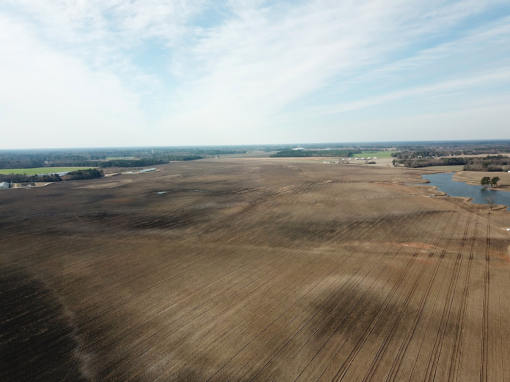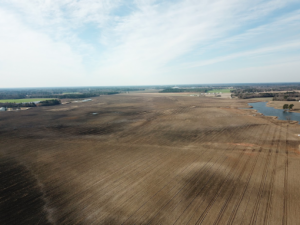Are water issues impacting your yields?
April 27, 2018


Water is the scarcest nutrient in dry-land agriculture. Even if you aren’t growing in a semi-arid or sub-humid region, water is the most critical input that many farmers struggle to properly manage. All other input decisions should hinge on it.
For most crops, it takes 4 inches of water just to grow the plant to full, mature size. For corn, it takes about 0.14 acre-inches (approx. 4000 gal) of water per bushel over the entire growing season. To put it in perspective, a 250-bushel corn crop would require 35 acre-inches of water (or about 992,000 gallons per acre) to reach full potential. Every inch of water beyond this goes toward increasing your yield. However, as with any crop input, water must be in proper proportion for maximum yields. Too much or too little water in any given time span can result in reduced yields, even if all your other input decisions were right on the money.
Precipitation, irrigation and soil moisture all contribute to available water for your crops, and thus your yields. However, there are other factors at play. Topography, soil type, fertility and water availability all affect your yields as well.
Topography
Having an accurate read on the topography of your farmland is a valuable tool. Visual surveys and experience driving the entire field show easily identifiable areas of concern. Steep slopes where erosion can deprive you of valuable topsoil, or depressions where ponding occurs, are obvious red flags, but there are other more subtle shifts in topography that can limit your yields too. Thorough land surveys using GPS tools like WM-Survey with RTK accuracy are essential to identifying steep slopes, rises, and low spots where action needs to be taken to improve crop yields.
Topography is also the most important factor when designing drainage systems. Understanding where the watersheds and different soil types are within the field determines where mains and laterals should be placed for optimal control of the water table. That is the key function of any subsurface drainage system.
Soil Type
Whether your soil is heavy sand, silt, clay, or some combination thereof, its composition greatly affects its ability to retain moisture and make it available to the planted crop. Clay soils are excellent at holding water, but they are also heavy and sticky. Heavy gumbo is great at holding water but not good at allowing excess to move through. Sandy soils are the opposite. They drain well with high hydraulic conductivity and great percolation. Appropriate spacing of tile laterals throughout the entire field is mandatory to achieve adequate drainage and produce consistent yields. If they are too far apart for the soil type, you cannot control the water table effectively; too close together and you waste money on tile and installation.
Fertility
Water can have a significant impact on soil fertility throughout the year. Heavy rain events or over-irrigation can cause significant erosion and wash away not only the thin layer of topsoil but the precious organic matter and nutrients within it. Most of the organic matter present in soil is in the topsoil and its loss directly reduces a soil’s fertility and thus your yields. Proper water management system design, especially when you factor in large rain events, can mitigate 80% or more of that erosion.
Nitrogen and phosphorus are two of the three most important nutrients your crop needs to meet its potential. They are also the two nutrients most susceptible to leaching. Nitrates readily dissolve and drain to depths below where plant roots can get to them. Phosphorus also leaches and moves downward in sandy soil. To combat this, a good understanding of soil composition and a good water management strategy are required so that all your input decisions can help your crop achieve its full potential consistently.
Water Availability
Drainage systems are invaluable during spring when water is so abundant it can threaten new plantings and even your ability to plant during the prime window. They’re also extremely important during the fall when you need dry crop conditions for a timely harvest.
During the hotter, drier months of the summer, however, nature doesn’t always cooperate by providing enough water for viable yields, and that valuable tile in your field can become even more important for maximum profits. With the addition of controlled drainage structures, you can have positive control of the water table throughout the field. Utilizing water control gates can turn your traditional tile drainage into a water retention system that keeps your water table at the appropriate level.
Early in the growing season, the gates can be left wide open to push your crop to increase root depth and tap into more nutrients, giving it better drought tolerance and fewer issues with lodging. Later in the growing season, they can be used to store water in your field and keep it readily available for increased yields.
Drainage control structures don’t just increase your yields. They have also been shown to reduce nutrient runoff and help farmers have better control of the water quality that exits their fields. Not only can a drainage control system boost your yields – they can help reduce your overall inputs as well!
With all these factors potentially affecting your yields, it is easy to see why proper water management is the solid foundation of every successful precision ag farm. Whether it’s too much, not enough, or in the wrong place, water issues impact every grower. Trimble Agriculture has been a leader in the water management space for 50 years now. We love listening to our customers because they give us most of our best ideas, and we take pride in developing products and end-to-end solutions that solve our customers’ most pressing needs.
Learn more about Trimble’s water management solutions.
Photo Credit: Daniel H., Vantage South Atlantic
About Author: Josh Shuler is a Product Manager with Trimble Agriculture covering multiple product lines including Water Management. He has more than 16 years of professional industry experience across the breadth of precision agriculture. He is originally from Missouri where he grew up on a row-crop and animal production farming operation. He’s a 2002 graduate of Northwest Missouri State University in Maryville, Missouri.
